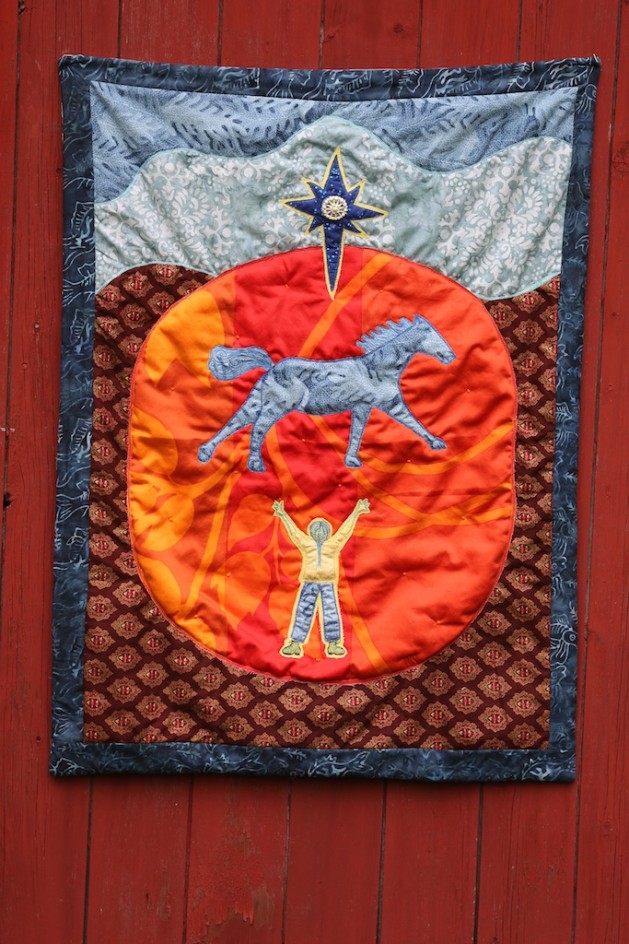
I’ve been privileged to witness and be a part of Maria’s wonderful and brave journey from a life of struggle and fear to a life of creativity fulfillment and adventure. We have both been on this trek together, and it is not without pain and suffering, but it is a life of meaning and accomplishment.
She is opening up this year in ways neither of us quite imagined. Another chapter has begun, one that will take her to South Dakota this fall to honor her art and help Blue-Star Equiculture deliver a storehouse full of horse feed and supplies to a group of Native-Americans making a sacred pilgrimage to a hallowed site.
It is a spiritual journey, and an affirmation of her increasingly original and powerful work.
In the second year of the Civil War, Abraham Lincoln authorized the mass hanging of 38 Dakota Indians – the largest mass execution in American history. The Dakotas had been hemmed in by treaty to a thin strip of land in Minnesota, there was no food or hunting there, and they were starving. The white federal agent for the reservation was famously quoted as saying “let them eat grass,” and the Dakotas – also known as the Eastern Sioux – rebelled, touching off a bloody war – atrocities on both sides – that only last a few months but that left hundreds of white settlers and an unknown number of Dakotas dead.
The uprising was brutally supressed by the U.S. Army. Initially, 300 Dakotas were scheduled to be hung for “murder and other outrages,” but Lincoln reduced the number to 38. They were executed together the day after Christmas in Mankato, Minn. In 2005, a Native-American named Jim Miller, a Vietnam Vet who had killed 38 people during his time in the war there, had a dream, a vision, in which he and other Native-Americans rode more than 300 miles on horseback from their South Dakota reservation to Mankato, Minnesota the day after Christmas, to honor the Indians executed.
His dream became a reality in 2008.
The ride on horseback to Minnesota, over long distances and often through bitter cold and blizzards, has been continued every year since. The first ride has been captured in a beautiful move – the Dakota 38 – offered free and available on CD and on YouTube. Maria and I watched this morning. We were both transfixed, the riders rode in a spirit of reconciliation healing and were greeted, sheltered and fed all along their route mostly by whites struggling to understand the truth about the destruction of the Dakota and other tribes.
It is difficult, I think, for many Americans, including myself, to come to terms with the genocide against the 16 million native people who inhabited the United States a few hundred years ago. Now, there are fewer than 300,000.
Maria’s connection to this event has become powerful and deep, still not clear. The logo she designed for Blue-Star and shown above – a symbol of the horse’s place in our culture and that of Native-Americans – is going out to South Dakota, it will be worn on T-shirts and used as a symbol of the trip by the people bringing the supplies to the horses and riders. A new and surprising way for her art to be received, understood and used.
Blue-Star has invited both of us to come along. Maria plans on going. I don’t think I can go, but my heart will surely go with her. This trip – like the one to Gee’s Bend, Alabama, to meet the Gee’s Bend quilters – is another big step on her journey to find her voice and her art. Perhaps both are the same thing. Maria is drawn to the horses in spiritual ways, so another step – something unimaginable just a few years ago that now seems as natural as breathing.
I do wish I could go, I admit it, but this may also be one of those things that is hers, not ours. That may be the message. Either way, I will be on that trip, as she has been on all of mine. Our connection is not bounded by space or geography.
